Design with “Pathos”
Kiyoshi Honda
―― Beginning of project
In the late 1970s, with Mitsubishi’s Jeep (produced under the license from AMC) gradually becoming obsolete, the idea to develop a successor soon emerged within the company. The Pajero’s starting point was the fact that its contract with AMC limited overseas exports, and in Japan it was being pushed out by the Toyota Land Cruiser. However, because of the lack of sales prospects in the market and the uncertainty of profitability, which was important for a new type of project, the official development of the Pajero could not be started, and in the summer of 1978, the design of the Pajero began as a preliminary project. The design team was led by Shinji Yokoyama and consisted of three exterior designers, including myself, and one interior designer.
―― Conceiving design concept
At the time, the Jeep CJ had already been on the market for 33 years and it was 20 years since the Land Rover Series II was launched. I thought, “The vehicle I am going to design may be in production for decades, so it must be a solid design that will never go out of style. ” In that sense, I felt that I had to work on it with a completely different mindset from that of the Sigma and the Lambda, which I had been in charge of just prior to this project.
In our technical center, there were the Mercedes G, the Ford Bronco and some other vehicles as reference, and I felt that the Mercedes had a good functional design, while the Bronco had the lifestyle image of a daily-use 4WD vehicle in the United States. I went to see the “Jeep Jamboree”, which was popular at the time, and went on a test drive of reference vehicles in Nasu Highlands with people from related departments. I experienced the joy of driving outdoors and wanted to express that feeling in the design. On the other hand, a product planner told me in a standing conversation, “I want it to be a vehicle that you can drive to Ginza Mitsukoshi, a high-class department store.” As I drew various sketches, I thought that the direction I wanted to take was to emphasize functionality, but at the same time, to combine the taste of what is now called a SUV.

Mercedes Benz G (left) Ford Bronco (right)
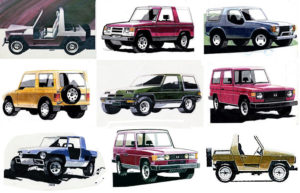
Various initial idea sketches
―― Design Selection
The three of us had our exterior idea sketches ready for review within the team. Masashi Iwata’s sketch was a modern design with rectangular headlights, which was pretty cool. Hisatoshi Katsuno, who had just joined the company, had a design that inherited the Jeep style. On the spot, The chief Yokoyama selected my proposal, and we immediately moved on to the 1/1 model. By that time, it had already been decided to exhibit the model at the Tokyo Motor Show, and it was to be a short wheelbase, open-top model. It was an integrated interior and exterior model made of clay and wood which was unusual as an initial model. At this point, Iwata was taken on another project. During this period, the Tredia, the Cordia, the Starion, and the Chariot were being developed in parallel, and our Design section was extremely busy, so the Pajero, which was still an unknown quantity, had to be handled with a minimum of manpower.

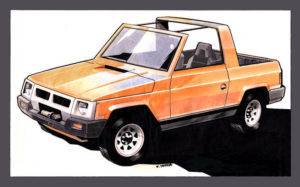
Proposal sketch by writer
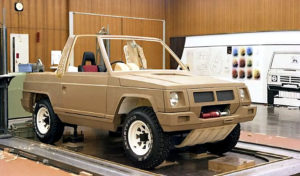
Initial model combining wood and clay
―― Concept car “PAJERO II“
After entering the model stage, I tried various ideas for the front area, but could not come up with a coherent design, and I felt a little nervous. While I wanted to keep it clean and functional, I also needed a face that was characteristic. In the end, I decided on two square headlamps to create a slightly sophisticated image, a bright orange body for show effect, and black bumpers and details for impact. The interior, designed by Hiroshi Mizutani, was also unified with this color scheme. The Pajero II attracted a great deal of attention at the 1979 Tokyo Motor Show, including from the international media. Incidentally, the name Pajero was inherited from the 1973 Jeep Pajero concept vehicle designed by Masao Oshima, and Haruhisa Otsubo, who was in charge of color at the time, was the godfather. Although the name has a negative meaning in English, I felt it was a very good combination of sound and letters while designing the name plate of the rear gate handle.
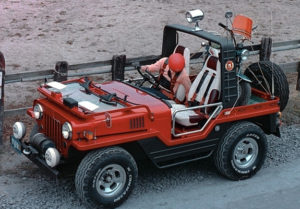
Concept vehicle “Jeep Pajero” in 1973
Although the Pajero II received low marks from Jeep enthusiasts and Defense Agency officials at the Consumer Survey held after the show, it was so well received by the general public that it was decided to split it up for general users, whereas it had been planned to be a vehicle for the Defense Agency as well. The leisure boom that began in the 1960s solidified the vehicle’s characterization as being suitable for both leisure and city driving.
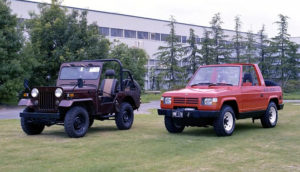
Pajero II under design study compared to Series 50 Mitsubishi Jeep
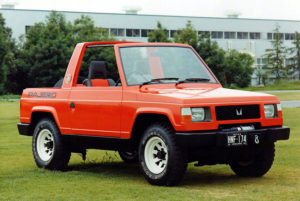
PajeroⅡ exhibited at Tokyo Motor Show
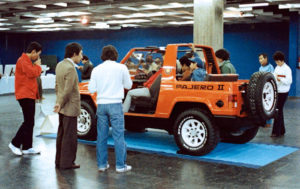
Consumer surveys held in various parts of country
―― Design for mass production
Now that the preliminary project had been converted into an official project, the design refinement work began amid much enthusiasm. For the headlights, I chose standerd round lamps to create a clear image rather than a sophisticated one, in consideration of export to underdeveloped countries, and combined them with the front corner lamps to create a distinctive face. The fact that this feature was carried over as the identity of the succeeding models was a meaningful factor in the creation of the product brand. The doors were to be shared with the four-door long model to be developed later, and I was concerned that this would result in an unbalanced design for the two-door model, but it turned out to be a fairly comfortable fit, perhaps due to the tall proportion.
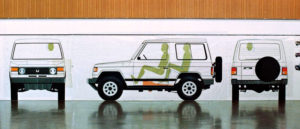
Design study for mass production
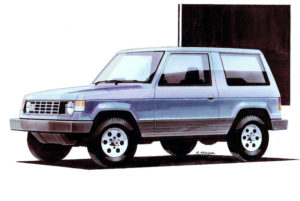
The layout of the rear area was a challenge. The exposed spare tire obstructed the visibility of the rear lamps and license plate, and visibility regulations in various exporting countries varied. This was not solved in the concept vehicle, but I eventually came up with the idea of adding a deep recess to the rear gate, and was able to solve the problem. The illustrated list of laws and regulations in each country prepared by the studio engineering group was very helpful in this planning.
Chief Yokoyama began to work also on the Cordia from the middle of the project, so we saw each other less and less often. Nevertheless, he gave me effective suggestions, and the design was finalized. He always said that judging the quality of a form should be based on a split-second glance. The difficulty of judging one’s own design is something that all designers experience, but I think he taught me the importance of switching one’ s mind and looking at the form with one’s bare senses.
At the design approval meeting of the executives, it was easily approved without any order at all. The initial monthly sales plan for the Pajero was low, at 1,000 units in Japan and 1,600 units overseas, probably because the executives’ attention was focused on the Tredia, the Cordia, and the Stallion, the global strategic models under development at the same time.
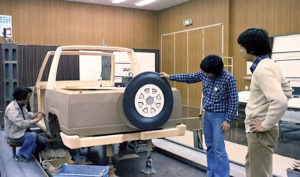
Checking recess with paper spare tire

Following the two-door model, work began on the design of the four-door model, but in order to reduce development costs, a clay model was not made, and the design was approved on the basis of my drawings alone. Originally, all the door lines of the 2-door model were horizontal, so the lines were simply extended backward, but the high-roof was a completely new shape, and it was unusual that the design was put into production without a clay model to confirm the design.
―― Surprising success
In 1982, the Pajero was launched, and in its first appearance in the Dakar Rally the following year, it won in the T1 class with non-modified production vehicles, and in 1985, it won all classes: Prototype, Marathon, and Non-modified production vehicles. I was amazed at the excellence of this vehicle’s capabilities, even though I was very late to the party. The domestic sales volume was just 670 units/month at the beginning, but the long model was added, it continued to grow every year, reaching 3,000 units/month at the end of the model life. The combination of advertising effect of Dakar Rally and the outdoor boom in Japan resulted such success. The Pajero even caused a phenomenon that overturned the conventional wisdom of car sales, as people switched from sports cars and luxury cars to the Pajero. The Pajero was sold overseas under the names Montero, Shogun, Dodge Raider, and Hyundai Galloper. Its reputation far exceeded initial expectations. In the Middle East, it was even dubbed the “Mercedes-Benz of the Desert.”
The Pajero’s design was later described as ” honest design” by Professor Kieth Teter, then Dean of Art Center College. Italian industrial designer Clino Castelli called it “design with pathos.” The word “pathos” has two meanings: one is emotion and the other is melancholy or tastefullness, and I think Castelli meant the latter. I was extremely grateful for their praise of my honest and tasteful design.
―― What I think now
The 1st gen. Pajero was planned with an uncertain future, but it matched the leisure boom in Japan perfectly, and its success in rallies earned it worldwide recognition. 9 years later, it was handed over to the next generation, which took a further leap forward and established the brand as a product. However, due to the company’s financial difficulties, it is regrettable that they had to completely withdraw from the production of the Pajero, especially since it had once reached such a height of its success. On the other hand, the Mercedes G, the Ford Bronco, and the Land Rover have all evolved in their own ways, and I believe that a revival of the more advanced Pajero is not impossible.
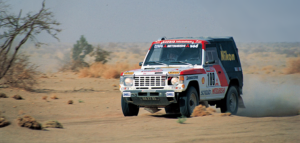
In1985 Dakar Rally, Patrick Zanilloli’s Pajero was first Japanese car to win overall victory
April 2022
Interior design aim at elation
Hiroshi Mizutani
―― Working alone
It was more than 43 years ago that I was in charge of the interior design of the 1st gen. Pajero, but for some reason it is one of the works that remain vividly in my memory. The reason is that I was able to immerse myself in the project in a pleasantly stress-free manner. I worked alone on this interior design, so the workload was large and tough, but the mental stress was equal to zero. The Lancer EX interior I worked on before this project was also almost solo, so I was not worried at all about working on this interior alone.
―― Interior and exterior design as one team
At the time I joined the project, it was a pre-project before the actual project, so Shinji Yokoyama, the head of the design team, suggested to change the conventional approach and have the exterior and interior design work as one team in the same studio. As for the exterior design, the direction was outlined in Kiyoshi Honda’s design at the completion of the preliminary stage. As the interior designer, my first impression when I saw his sketches was very favorable. The overall appearance was gallant, and unlike the Jeep, which is a military vehicle, I strongly felt that this was a future off-road vehicle that was sturdy but could also be driven in the city. This was where the interior design process began. The first design model we worked on was a full-open type that was popular in the Mitsubishi Jeeps for civilian use. The interior, however, had no cabin, so everything was exposed. That was probably one of the reasons why Yokoyama wanted to proceed with the design as an all-in-one model, inside and out. When I got to work, it didn’t take me long to generate the design concept.
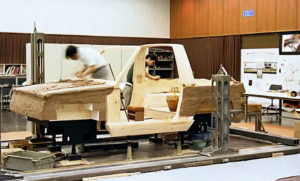
Making integrated interior/exterior model, instrument panel planned on right wall
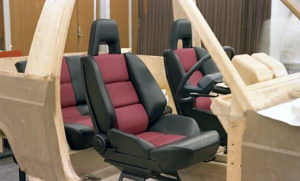
Integrated interior/exterior model with seats and instrument panel temporarily installed
―― Creating sense of elation as off-road vehicle
The concept was the layout adopted for the Lancer EX, for which I had previously been in charge, where the meters were placed on top of the functional shelf-type instrument panel body, and the control panel was concentrated in the center. This concept was even more suitable for the Pajero, and I added an RV touch to match the exterior design.
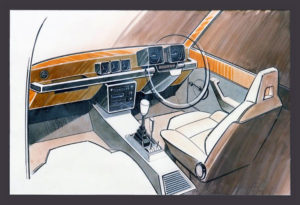
In this interior design, I wanted to propose not trend-conscious styling as in the exterior, but rather a functionality that people can touch and operate as an off-road vehicle, and to create an extraordinary feeling that sets it apart from normal passenger cars from the moment one sits in the driver’s seat, and to create a sense of excitement that says, “I am about to drive an off-road vehicle!” In addition to the gearshift lever, there is a transfer lever in the center of the floor, which by itself gives an unusual impression, but I wanted to further emphasize the symbolism of an off-road vehicle in the eye range of the upper surface of the instrument panel, something that is not found on other vehicles. For this reason, I referred to the cockpits of aircraft and helicopters, as well as the operation panels of cranes and other special vehicles for work, rather than the instrument panels of cars.
―― Adopting inclinometer
Then I had a flash of an idea for an gyroscopic attitude indicator, which is found in the cockpit of aircraft. I wondered what it would be like to place this in the center of the instrument panel in a modular arrangement with some other gauges. In the end, the gyro mechanism was too costly to use, but it was almost as functional and of a higher level than ever before for off-road vehicles, and to my knowledge, this was the first time in the world that a 3-D inclinometer was equipped in an automobile.
The dual meter in front of the driver’s seat was an independent type reminiscent of a big motorcycle, with a large, simple and sporty design. The instrument panel was basically shelf type, with the top surface made of embossed steel for magnets and the front surface softly padded for shock absorption. I proposed a large, easy-to-operate dial type air-conditioning switchs on the center panel, but unfortunately, it ended up being a lever type because of the high cost of using bevel gears in the structure. However, as a side note, I did not give up on the idea and proposed it again five years later for the sixth-generation Galant for which I was in charge, and finally succeeded in realizing it.
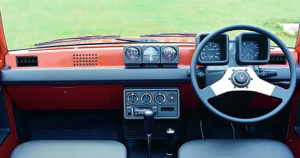
Inclinometer in middle of triple meter array in center of instrument panel
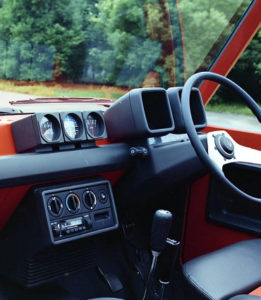 |
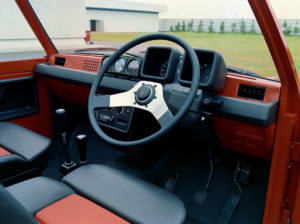 |
Other than the instrument panel, various ideas were also incorporated into the seats. The front seat is a suspension seat designed for driving on rough roads. Furthermore, it was designed to be thoroughly functional with a shape that provides a good holding as off-road vehicle seats. In addition, the seat cover was made of breathable knitted leather in the orange center portion. However, for the mass-production model, the high cost of the special leather was dropped, and fabric was adopted.
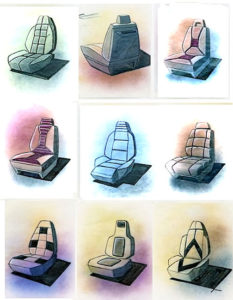 |
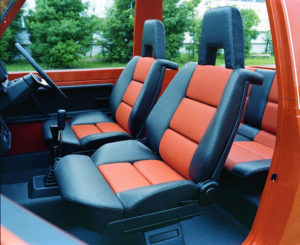 |
―― Response from motor show and product clinics
This was a rewarding project in which the team worked together with the stance that we were trying to pioneer a new generation of real off-road vehicle. On the other hand, at the time, no one in the company could have imagined that this vehicle would later develop into a major model for Mitsubishi Motors, and since it did not attract much attention from executives during the design development, work proceeded at our own pace and faster than expected. In the midst of all this, we decided to exhibit the car as a concept car at the Tokyo Motor Show in the fall of 1979 and see how visitors react to it, which would lead to the official project. With this motivation, work on the model proceeded at a rapid pace, and we managed to get it ready in time for the motor show.
As we had hoped, there was a great response at the Tokyo Motor Show, foreshadowing the beginning of the RV boom. After the motor show, we brought the Pajero II, the motor show exhibit, to the Aomori Grand Hotel and conducted a two-day product clinic for dozens of salespeople from dealerships in the Tohoku area. Honda, modeler chief Katsuki Fukui and I traveled to participate in the clinic. The winters in Tohoku are deep with snow, and real 4WD vehicles are indispensable for daily life. The Jeeps of the time may have met the performance requirements, but in terms of usability and comfort, they were old vehicles, and the local people felt that they had reached their limits. As it turned out, this was indeed the long-awaited new model, and they were eager for it to be released as soon as possible.
The response to the Pajero II was so overwhelming that they wanted to continue the product clinic in Sapporo after the Aomori, so we promptly airlifted the vehicles and conducted an additional clinic. Thanks to the response in various places, the project finally became official at the end of 1979, and the same members started working on the design, starting with the short metal top, and the basic design was successfully approved in March of the following year.
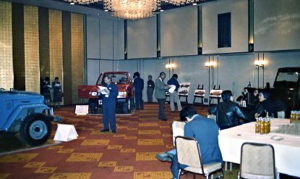
Survey at Aomori Grand Hotel that received great response
―― ”RV meter” that later led to
After that, it had been previously decided that I would be transferred to the advanced design team from April of that year, so I wanted to finish the project myself, but after receiving basic approval, I handed over the work to Kokuhiro Shibuya and Katsushi Kunimoto for final approval, and they brushed up on the design. It was a genuinely pleasant job that I was able to proceed with, and I can say that this experience had a tremendous impact on the project design works I was later involved in.
The combination meter including the inclinometer that was adopted was called the “RV meter” in our development division, and was widely used in the subsequent Pajero, Pajero Mini, Delica, RVR, etc. It became the symbol of Mitsubishi RVs for 17 years from the introduction of the 1st gen. Pajero in 1982 to 1999. I am very happy and proud that this meter has become a emblem of Mitsubishi RV interiors, which was my initial goal. This interior design, which gave me such a sense of accomplishment, is a job that will remain in my memory.
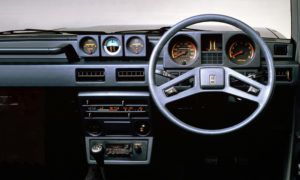
Final design instrument panel
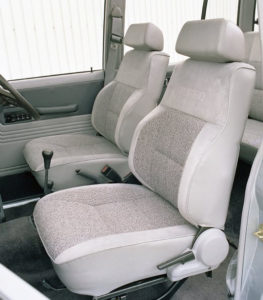
Final design seat
July 2022
Pajero “Exceed” color and trim design
Masashi Iwata
―― High-end SUV version added to Pajero
The Pajero started out as a short-body van, but with the aim of further expanding the market, new variants were introduced every year, including the short wagon, the long-body van and wagon, and the mid-roof version.The sales volume had increased by 30% every year, boosted by the success in the Paris-Dakar Rally. Under these circumstances, the product planning department planned to add an new attraction to the Pajero for the domestic market. They were focusing on the change in user demographics. The number of middle-class and high-end passenger car users with high incomes who were switching to the Pajero was on the rise.
At the time, typical examples of off-road vehicles were the Land Cruiser and the Safari, but their rugged and muddy image was difficult for the average passenger car users to handle. The Pajero, on the other hand, was seen as a more modern and sophisticated off-road vehicle that could be used like a passenger car in town, rather than a muddy off-road vehicle. A plan to introduce an additional high-end version of the Pajero, that would be the image leader of the brand, was outlined to the design department.
The Product Planning Department’s plan was to sell just 50 units per month. This was the best that could be expected, as a luxury version of an off-road vehicle was a project that exceeded conventional concepts.
―― ”Exceed” name of high-end version Pajero
I was in charge of color and trim for the Pajero, and the first thing that came to mind when I was briefed by the Product Planning Department was the British Range Rover, which was also mentioned as a target in the plan that was brought to us. The Range Rover reminded me of a car used by wealthy people to visit their farms or to travel to their vacation homes. It was a simple and stylish cross-country car with a full-time 4WD mechanism and styling reminiscent of an estate car, with the spare tire located inside the car. I was a bit baffled by the idea that the Pajero could have the image of a luxury SUV like the Range Rover.
With monthly sales of 50 units, we cannot spend much on setup costs. The only major changes made to the exterior were the addition of an exclusive body color (2Tone) and aluminum wheels. Interior changes included leather seats and a leather-wrapped steering wheel, so most of the changes were in the color and trim design. The grade name for the high-end version of the Pajero was decided to be “Exceed,” which would later become the name that would establish the Pajero’s reputation.

1970 Range Rover
―― What exactly in color and trim design of “Exceed”
First, the body color was changed from the conventional 2-tone paint to a 3-way 2-tone paint in order to clearly differentiate it among the Pajero series. The design source for this change was the wood grain decals used on large station wagons in North America, which were also used on the the Toyota Crown, the Nissan Cedric, and the Mitsubishi Galant Sigma wagon in Japan. Fortunately, the Pajero had press lines on the body that facilitated the 3-way 2-tone paint scheme. A sample car was made based on the sketches, and the result was much smarter than the conventional 2-tone paint, and it was well differentiated. The 3-way 2-tone paint was previously used on the 2nd gen. Lancer Fiore sedan, and was a unique Mitsubishi design not seen on other companies’ models. In addition to this, the side pillars and sashes were painted black, giving the windows a cleaner look. Exclusive machined aluminum wheels also contributed to the luxurious appearance.

Sketch by Hidetoshi Aoki, in charge of exterior design

3Way 2Tone paint on Exceed (left) 2Tone paint on Wagon (right)
As for the seats, the headrests were changed to an optional donut type, which gives a sense of luxury and openness. For the seat upholstery, soft and fluffy velour was the mainstream seat upholstery for Japanese luxury cars at the time, and genuine leather was an option for all manufacturers, but for the Exceed, genuine leather seats were planned to be the a standard equipment. In order to make the seats suitable for the Pajero, I considered using a combination of leather and fabric. When driving off-road, occupants may be shaken in various directions. If the entire surface of such seats were covered with leather, the occupants would slide around and feel uncomfortable. The rear seat, which is supposed to be used fully flat, would be even more slippery. Therefore, the center of the seat back and seat cushion were covered with tweed fabric to prevent slipping, while the sides of the seat back and cushion and the headrests were covered with genuine leather to prevent slipping. Moreover, the addition of sewing lines and wrinkles caused by the use of stitches gave the seats a genuine look of leather.
For the fabric, I chose wool fabric from many suggested fabrics, drawn by the appeal of the material. At the time, a representative of Kawashima Textile, a fabric manufacturer, told me that this was the first time in the world that wool fabric was used for car seats. However, it was found that 100% wool would not meet Mitsubishi’s specifications, and after much improvement with Kawashima Textile, a wool-blend fabric was finally selected. To further emphasize the use of wool, wool mark tags were attached to the seats as a proof of the use of wool-blend fabric. This fabric is also inserted into the door trim and surrounded by shiny molding to give the appearance of a high-end vehicle. The combination of genuine leather and fabric seats is now often seen in sports models, but at the time it was a rare attempt.
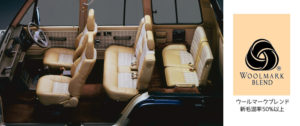
EXCEED interior (left) Woolmark blend tag (right)
Later, the “Super Exceed” was added with a minor change, and along with the modification of the seat shape, the wool-blend fabric was changed to regular fabric due to the cost reduction. However, the non-slip effect by the combination use of genuine leather and fabric was retained.
The 3-way 2-tone paint was continued on Exceed models with over fenders, and was used on all subsequent Pajero model changes (except the 3rd generation) until the end of Pajero sales. It became widely recognized as an exclusive paint for high-end models.

3-way 2-tone painting inherited in 2nd/4th generation Pajero
―― Eventually, Excced becomes Mitsubishi’s top earner
When the Exceed, which was developed with a focus on color and trim design, was introduced to the market, I was surprised that it suddenly sold 1,000 units, perhaps because it stimulated the users’ sense of satisfaction as a passenger car. Tsuyoshi Imasaki, the product planner in charge of this project at the time, later said, “I had no idea that it would sell so well; I had no grasp of the market at all, and it was a happy miscalculation. ” Market demand continued to grow, and in addition to the original Exceed, the Super Exceed and the Super Royal Exceed were added to the lineup, The Exceed series (priced between 3 and 5 million yen) accounted for 50% of Pajero’s domestic sales (averaging approximately 2,000 to 3,000 units per month during this period) and became the flagship model of Pajero and Mitsubishi’s top earner.
After the introduction of the Pajero Exceed, other manufacturers’ off-road vehicles began to compete with the Pajero by adding high-end models and special editions, and the number of models similar to high-end passenger cars increased, including models with Recaro seats and leather seats, as well as a use of the Alcantara. In the beginning, I wondered if such a luxurious off-road vehivle would sell in Japan, but to be honest, I was happy to see the Exceed become a driving force in the off-road vehicle market.
April 2022